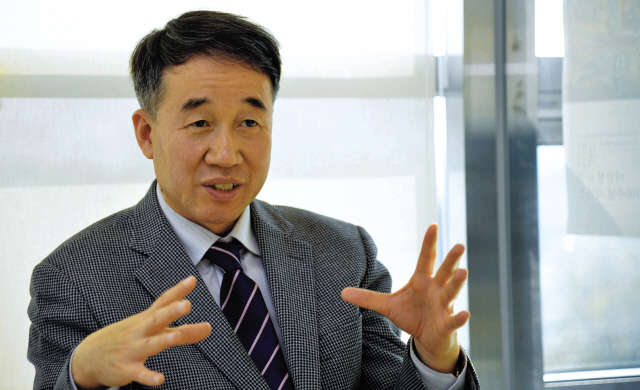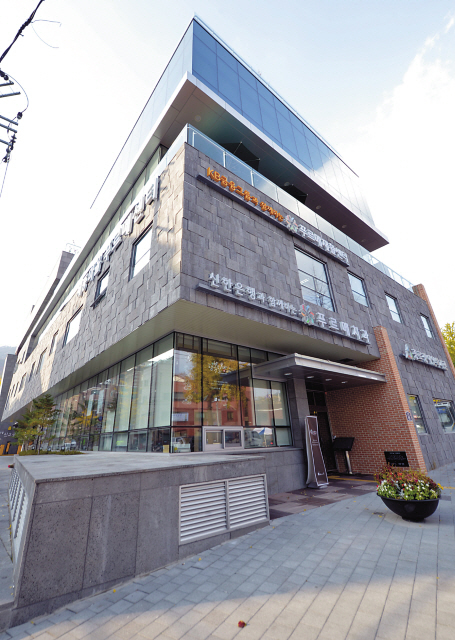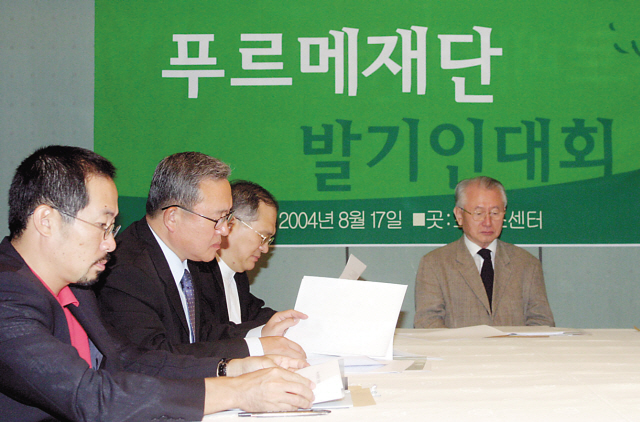Home of 3,000 miracles borne of personal tragedy
Guten Paik of Purme Foundation on a mission to help the disabled
By Korea HeraldPublished : Nov. 16, 2012 - 20:33
From outside, it looks no different from ordinary commercial buildings lining Seoul’s streets. A step inside and the impression is totally different.
A tiny bakery caf at one corner of the lobby is staffed by persons with disabilities. A group of handicapped children gather around at another corner, bursting into laughter from time to time. Right in the middle stands a big, red donation box.
A signboard on the wall says that this is a place for disabled children. Upstairs, there are play-therapy rooms, a dental clinic, an oriental doctor’s clinic and a physiotherapy clinic.
“This is a building of 3,000 miracles,” said Paik Kyung-hak, the man behind Purme Rehabilitation Center, aka Mr. Guten (good) Paik.
A tiny bakery caf at one corner of the lobby is staffed by persons with disabilities. A group of handicapped children gather around at another corner, bursting into laughter from time to time. Right in the middle stands a big, red donation box.
A signboard on the wall says that this is a place for disabled children. Upstairs, there are play-therapy rooms, a dental clinic, an oriental doctor’s clinic and a physiotherapy clinic.
“This is a building of 3,000 miracles,” said Paik Kyung-hak, the man behind Purme Rehabilitation Center, aka Mr. Guten (good) Paik.

The center was built with 8.3 billion won ($7.6 million) in donations from about 3,000 individuals and companies ― all so miraculous to Paik that he described them as such.
“Come in the afternoon, you’ll get a better sense of what our place is like. Children are all over here, climbing up and down the sofas, pulling decorations from the wall and playing with toys and non-toys,” he said, with a disarming smile.
And that is precisely what Paik wanted it to be like ― a place of no boundaries or limitations. After all, these kids encounter barriers at every turn outside.
“Like the name of our foundation, I wanted to build a place where children’s dreams grow like leafy, green mountains,” he said. “Purme” is the Korean word for a lush, leafy wood.
Located near Gyeongbok Palace in Jongno, Seoul, the center opened in July. Clinics and therapy centers are about 70 percent booked now, with Paik and staff at his Purme Foundation coming to grips with what it is like to run hospitals ― something they had dreamed of for the past seven years.

“The fact that I have come this far, running a four-story building dedicated to rehabilitation of disabled children, is a miracle,” said the 49-year-old executive director of Purme.
In 2004, Paik established the foundation from scratch, with money from his own pocket. It was six years after his wife lost a leg in a car crash and became wheelchair-bound.
Before the accident in 1998, Paik, then a mid-career journalist who had just finished a two-year study of German unification at a university in Munich, Germany, had a completely different goal in life.
After taking his family ― his wife and daughter ― on a trip to Scotland, he had planned to return to the tenacious journalism world back in Korea, to write in-depth stories on the country’s diplomacy, unification and other lofty issues.
“We were driving to Edinburgh, Scotland, when my wife said she wanted to get something out of the trunk. I pulled over, stood beside our car while my wife opened the trunk,” he said.
“The next thing I remember is waking up underneath the car (which hit us) and finding my wife lying in a pool of blood and my daughter crying, looking at us from the backseat of our car which was pushed far away.”
For the next three months, his wife was unconscious, in critical condition. Doctors at the Scottish hospital told him to be prepared for her death.
Miraculously, she recovered from the brink of death. She was soon transferred to a hospital in Germany, where she underwent intensive rehabilitation treatment for a year and a half. In 2000, Paik, his wife and daughter returned home.
It didn’t take him long to realize how harsh his country was to those stricken by tragic accidents.
“There was no bed available in hospitals here for my wife. People told me that those in more severe conditions (than my wife) have to wait for months to be hospitalized.”
It was another face of Korea that even Paik, a journalist for over 10 years, hadn’t known before.
“We seldom encounter disabled persons on streets, buses or in shopping malls. Where would they be?” he said.
Social stigma and discrimination; lack of adequate health care and rehabilitation services; and inaccessible transport, buildings and information ― all these effectively lock people with disabilities inside their home, he stressed.
“Soon after returning to Korea, I decided to devote myself to building hospitals that my wife and I had experienced in Europe,” he said.
With no money, network or information to realize his dream, the first thing Paik did was to quit his journalism job and make money ―lots of it.
“To run a hospital, you should be either a medical doctor or a legally recognized foundation. And to set up a foundation, you need money,” Paik said.
In 2002, he opened Oktoberfest in Gangnam, southern Seoul, the country’s first brewery-pub, together with friends. The business went well and three more pubs opened. In 2004, Paik decided it was time that he moved on to the next stage ― the foundation.
In 2004, Paik established the foundation from scratch, with money from his own pocket. It was six years after his wife lost a leg in a car crash and became wheelchair-bound.
Before the accident in 1998, Paik, then a mid-career journalist who had just finished a two-year study of German unification at a university in Munich, Germany, had a completely different goal in life.
After taking his family ― his wife and daughter ― on a trip to Scotland, he had planned to return to the tenacious journalism world back in Korea, to write in-depth stories on the country’s diplomacy, unification and other lofty issues.
“We were driving to Edinburgh, Scotland, when my wife said she wanted to get something out of the trunk. I pulled over, stood beside our car while my wife opened the trunk,” he said.
“The next thing I remember is waking up underneath the car (which hit us) and finding my wife lying in a pool of blood and my daughter crying, looking at us from the backseat of our car which was pushed far away.”
For the next three months, his wife was unconscious, in critical condition. Doctors at the Scottish hospital told him to be prepared for her death.
Miraculously, she recovered from the brink of death. She was soon transferred to a hospital in Germany, where she underwent intensive rehabilitation treatment for a year and a half. In 2000, Paik, his wife and daughter returned home.
It didn’t take him long to realize how harsh his country was to those stricken by tragic accidents.
“There was no bed available in hospitals here for my wife. People told me that those in more severe conditions (than my wife) have to wait for months to be hospitalized.”
It was another face of Korea that even Paik, a journalist for over 10 years, hadn’t known before.
“We seldom encounter disabled persons on streets, buses or in shopping malls. Where would they be?” he said.
Social stigma and discrimination; lack of adequate health care and rehabilitation services; and inaccessible transport, buildings and information ― all these effectively lock people with disabilities inside their home, he stressed.
“Soon after returning to Korea, I decided to devote myself to building hospitals that my wife and I had experienced in Europe,” he said.
With no money, network or information to realize his dream, the first thing Paik did was to quit his journalism job and make money ―lots of it.
“To run a hospital, you should be either a medical doctor or a legally recognized foundation. And to set up a foundation, you need money,” Paik said.
In 2002, he opened Oktoberfest in Gangnam, southern Seoul, the country’s first brewery-pub, together with friends. The business went well and three more pubs opened. In 2004, Paik decided it was time that he moved on to the next stage ― the foundation.

Purme was established with Paik’s share in Oktoberfest and about 1 billion won ― half the money his wife received in compensation from the insurance company after eight years of legal battles.
In 2005, he started the fund-raising campaign to build a rehabilitation center for disabled children ― the Purme Rehabilitation Center.
The past seven years were an emotional roller-coaster of hope and despair for Paik.
“I was basically in a position of having to beg for other people’s interest, support and money,” he said. “Some elegantly turned me down on the spot. Others looked so moved by my story and willing to help, but were never reached again.”
There were moments too that brought him to tears of gratitude.
“Working for the disabled, I met so many good people. It’s like I am surrounded by people with the warmest hearts in our society.”
Watching children overcome their disability with help of his center is another moment that encourages him to hold on to his self-imposed mission.
Paik recalled a baby girl with cerebral palsy named Min-hui. When she first came to his foundation some years ago, she couldn’t even hold her head up. His foundation had just opened an oriential rehabilitation clinic at a corner of his office, where a volunteer doctor came to treat patients, including Min-hui, for two hours a day, four times a week.
“One day, I got a phone call from her mom, shouting that Min-hui had walked. I cried. We all cried,” he said.
“There are over 300,000 children in need of rehabilitation care in Korea,” he went on. “If treated in time and with adequate intensity, many of them can grow to lead an independent life, not relying on the sacrifice of the parents.”
Official government data puts the number of disabled persons in Korea at 2.5 million, about 5 percent of its total population. If those who are not registered with authorities as being disabled are included, the number would top 3 million, experts say.
By Lee Sun-young (milaya@heraldcorp.com)
-
Articles by Korea Herald



















![[Today’s K-pop] Treasure to publish magazine for debut anniversary](http://res.heraldm.com/phpwas/restmb_idxmake.php?idx=642&simg=/content/image/2024/07/26/20240726050551_0.jpg&u=)